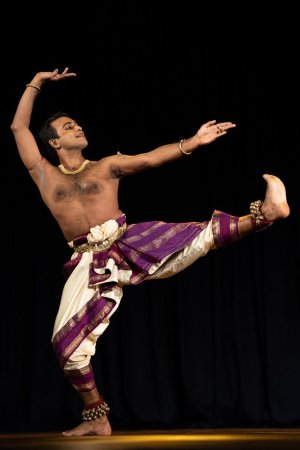
|   |

|   |
Simplicity, and authenticity marked K. Sarveshan's performance - Anita Vallabh e-mail: anitavallabhofficial@gmail.com January 11, 2025 Sarveshan's performance on 21 December 2024 at Narada Gana Sabha, was simple and authentic, much like his natural self. Although his performance began with a musical hiccup—with the fluctuation of tala in the beginning of the mallari before settling into the required madhyamakalam—his entry and subsequent rendition remained unwavering. This is a testament to his talent as a dancer who is also trained in music and possesses a virtuosic ability to wield the nattuvangam. Following the mallari, he moved on to the varnam in Surutti by Subbarama Dikshitar, Sami enthani telpudura choreographed by The Dhananjayans. As a rasika, I was captivated by Sarveshan's performance of the varnam, which beautifully showcased the evolving notions of male and female bodies over time. It was refreshing to witness a male dancer embodying what was once envisioned for a female body, without resorting to exaggerated posturing. Sarveshan's portrayal of the Duti, a messenger, was particularly captivating. He addressed the King Muthuswami Ettendra as Lord Madhava, imploring him to show compassion toward his proficient and beautiful friend, who is deeply in love with him. Sarveshan's Duta befittingly exuded a respectful and confident demeanor throughout the varnam. Interspersed with crisp jatis, Sarveshan effortlessly conveyed the pangs of the nayika with the emotional detachment of a messenger.  Sarveshan The next presentation featured Arunachala Kavirayar's Yaaro ivar yaaro in Bhairavi, a renowned song from the epic Ramayana. In this song, the poet eloquently describes Rama's emotions upon first encountering Sita and being captivated by her beauty. Sarveshan performed this song with a graceful and gentle demeanor, befitting a noble prince. He embodied Rama in the way he lovingly looked up at Sita and seemed enchanted by her beauty. Following this, he moved on to a padam, Neelakantare vaarum by Sujatha Vijayaraghavan in ragam Begada. The central theme of this piece addresses one of the most pressing concerns of our time: the detrimental impact of careless human activity on the rise in greenhouse gas emissions. In a playful and sarcastic tone, the Bhakta addresses Lord Shiva, inquiring whether the deity who once valiantly consumed the halahala poison during Samudramanthana is now hesitant to confront and eliminate the toxicity emanating from environmental degradation. The Bhakta further emphasizes this point through imagery of fire and smoke pollution. Sarveshan endearingly assumed the role of the Bhakta. The eloquently crafted lyrics of this padam resonate with a broad audience, compelling us to engage in a comprehensive discourse on the intersection of the arts and ethical living, as well as the role of artists in conservationist activism. Overall, Sarveshan's performance as a dancer was commendable. However, for an immersive experience, the aesthetics of the space and lighting are crucial. Unfortunately, these aspects were lacking in this performance. When a dancer lacks the opportunity to rehearse, engage with stage design and lighting, and performs on a stage illuminated by white light and devoid of aesthetic quality, there is a significant diminution in their ability to effectively engage the audience.  Anita Vallabh is an Adjunct professor at the University of Hawaii, author, Yoga instructor and dance critic. She lives in Boston, USA. |